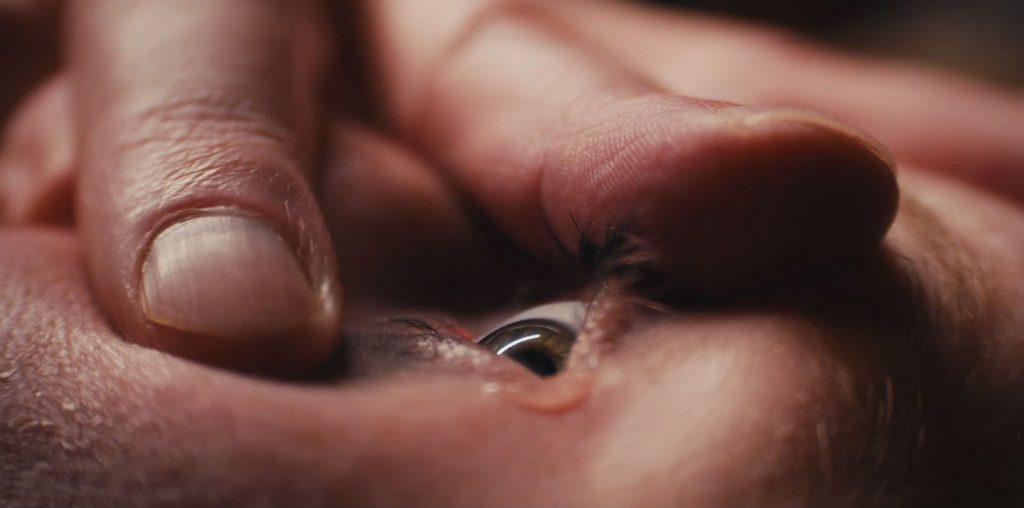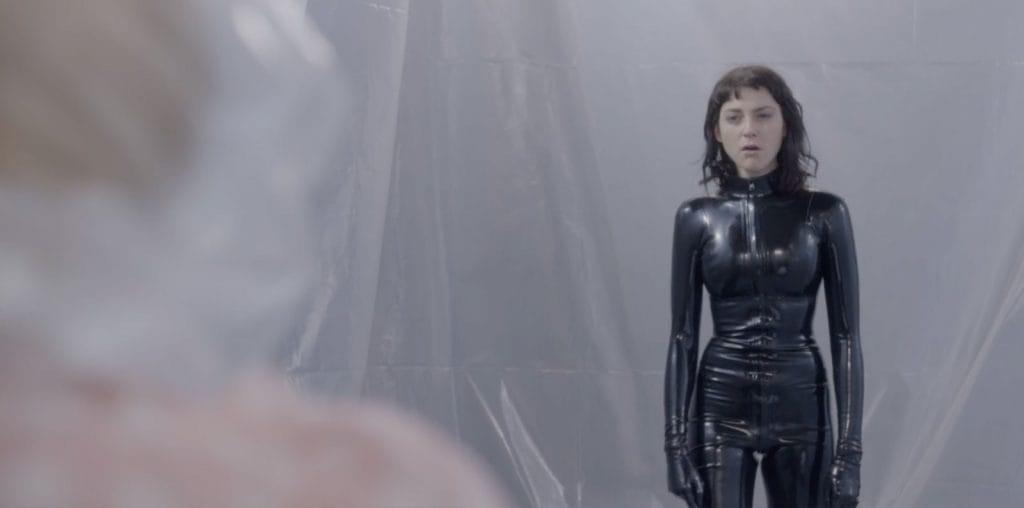
BOOTLEG FILES 370: “Stage Door Canteen” (1943 all-star wartime flag-waver).
LAST SEEN: The entire film can be seen on several online sites.
AMERICAN HOME VIDEO: As a public domain title.
REASON FOR BOOTLEG STATUS: An expired copyright.
CHANCES OF SEEING A COMMERCIAL DVD RELEASE: Eh, phooey – this one is strictly a public domain fixture.
During World War II, the American Theatre Wing operated the Stage Door Canteen in New York City. Located off Times Square, the Stage Door Canteen served as a recreational center for servicemen who were in the big city. Free food was provided and prominent entertainers volunteered their time as both performers and kitchen- and wait-staff. Aspiring young actresses served as hostesses, and they offered the servicemen a brief partnership for a dance floor spin and a sympathetic audience for conversation – after all, most of the servicemen passing through the establishment would soon be shipped overseas to face frontline battles.
The Stage Door Canteen quickly became a major success and a second version was opened in Hollywood. In 1943, independent producer Sol Lesser decided that the Stage Door Canteen would be an inspirational subject for a feature film. He paid the American Theatre Wing $50,000 for the rights to the story and created exact replica of the venue on soundstages in New York and Hollywood. (The actual Stage Door Canteen was in full use and could not be shut down to accommodate a film shoot.)
What was extremely unusual about the resulting film, “Stage Door Canteen,” was that it doubled as a fundraising event for the American Theatre Wing. United Artists, the film’s distributor, donated 90% of the box office profits back to the theatrical organization, thus allowing it to continue funding its Stage Door Canteen operations during the war. Even more remarkable was that the Screen Actors Guild put one of its key rules on temporary hold and allowed the A-list members of the film’s all-star cast to appear in “Stage Door Canteen” gratis.
The resulting film, however, turned out to be rather peculiar. To its credit, it provided some notable appearances by many icons of 20th century entertainment. But on the other hand, it represented an exercise in unfocused overkill that, ultimately, steamrolled its good intentions under 132 grueling minutes of flag-waving hokum.
“Stage Door Canteen” follows the travel of four soldiers on their way to war. The soldiers go by the nicknames of their home states: California, Texas, Dakota and Jersey. Stopping off for a brief R&R period in New York, they decide to visit the famed Stage Door Canteen. Naturally, they meet the prettiest hostesses in the venue and romance ensues.
On its own terms, the plot could have carried a satisfactory little wartime romance. However, “Stage Door Canteen” spends most of its running time pummeling its fragile core with a relentless nonstop express rush of big band jamborees, comic star-turns and bizarre all-star cameos. In many ways, the film feels like the most elaborate example of attention deficit disorder ever put on the screen.
“Stage Door Canteen” keeps most of its stellar focus on the Broadway royalty. This is actually the one true asset of the film, since most of the major Broadway stars of that era only made occasional film appearances – and in the case of the legendary Katharine Cornell, this is the only time that she ever appeared in a movie. Thus, any theater addict who comes to “Stage Door Canteen” can thrill to rare film appearances by the likes of Helen Hayes, Alfred Lunt and Lynn Fontanne, Tallulah Bankhead, Ethel Merman, Gypsy Rose Lee, Ed Wynn, Dame May Whitty and Cornelia Otis Skinner. (Jane Cowl and Gertrude Lawrence reportedly have unbilled walk-ons.)
While this all sounds wonderful, the weird thing is that most of these luminaries are involved in somewhat unusual shtick. Lunt and Fontanne have a light bickering exchange in a kitchen (she is making sandwiches, he is cleaning dishes). Katharine Cornell does an impromptu rendition of the balcony scene from “Romeo and Juliet” with a star-struck soldier while she serves oranges to a food line. Tallulah Bankhead – who was celebrated for her bawdy private life – was inexplicably given the opportunity to quote Biblical scripture. (Incredibly, she pulls it off!)
If that isn’t confusing enough, the film also packs in classical violinist Yehudi Menuhin plus blaring performances by six major big bands from the 1940s: Count Basie, Xavier Cugat, Benny Goodman, Kay Kyser, Guy Lombardo and Freddie Martin bring their musicians together for swinging numbers. While this might seem like an abundance of riches, it actually becomes exhausting. A young Peggy Lee is the uncredited singer for the Benny Goodman musical sequence, while the legendary Ethel Waters fronts the Count Basie band. (Waters, Basie and his band are the only African Americans in the film – beyond a brief shout out to the Chinese army, “Stage Door Canteen” gives the impression that only white people were involved in the Allied cause during World War II.)
But if that’s not enough, there are also a number of overlong comedy sequences. Ventriloquist Edgar Bergen brings out his smart-aleck dummy Charlie McCarthy for a burlesque fortune-telling act, while Ray Bolger indulges in a zany dance while singing a tune that compares his girlfriend to Lou Costello. Harpo Marx runs amok for a spell, and British star Gracie Fields pops out of a large box to provide her own brand of comic relief. None of this is even vaguely funny – in fact, the only genuine laugh in the film involves a Breen Office-evading gag with Franklin Pangborn (a comic actor who specialized in playing effeminate characters) admiring the muscles of movie Tarzan Johnny Weismuller.
A few non-Broadway stars, such as Merle Oberon and George Raft, also show up for fleeting appearances. Katharine Hepburn, who left Broadway in the 1930s for Hollywood, is used as a deus ex machina in the affairs of one of the soldiers and the hostess he falls in love with – which is nice, considering that most of the film is spent focusing on everything but the original plot.
The wartime years were marred with numerous commodity shortages, and it seems that quality entertainment was part of the deficit. But back in the day, no one complained. “Stage Door Canteen” was a popular film with audiences, and the success of its release encouraged Warner Bros. to put together a very similar effort called “Hollywood Canteen,” which was distributed in 1944.
With the end of World War II, the Stage Door Canteen was shut down. While its contribution to encouraging wartime morale was fondly remembered, the film version of the venue was forgotten – at least by United Artists, which neglected to renew its copyright. The film fell into the public domain and has been duped endlessly (and mercilessly) for years. (The film’s score, however, is still copyright-protected, so anyone who wants to rescue the film from the public domain could probably work from that aspect of the work.)
Many of the dupes of “Stage Door Canteen” that are floating around are missing nearly 40 minutes of footage. Some of this was scissored out during the height of the Cold War – a sequence involving Sam Jaffe paying tribute to Soviet soldiers was hastily jettisoned. Also missing is a gag appearance by Johnny Roventini, a dwarf actor who earned his celebrity by dressing as a hotel bellboy while calling out for the Philip Morris cigarette brand.
But even its truncated form, “Stage Door Canteen” is something of a challenge to endure. Anyone who seeks it out should consider it as a product of its time, albeit not a very good product.
IMPORTANT NOTICE: The unauthorized duplication and distribution of copyright-protected material, either for crass commercial purposes or profit-free s***s and giggles, is not something that the entertainment industry appreciates. On occasion, law enforcement personnel boost their arrest quotas by collaring cheery cinephiles engaged in such activities. So if you are going to copy and distribute bootleg videos and DVDs, a word to the wise: don’t get caught. Oddly, the purchase and ownership of bootleg videos is perfectly legal. Go figure!


TCM shows this film at least once a month, fully intact, so one can just wait for it to air or make a copy themselves. It is quite a remarkable film.
I wish I could remember whether it was Stage Door or Hollywood Canteen I saw. My vague notion that Tommy Dorsey’s orchestra was in it indicates the latter. I suspect the films would be nearly identical anyway. I enjoyed it for the evocation of the 1940s Hollywood scene, and the great big band music.